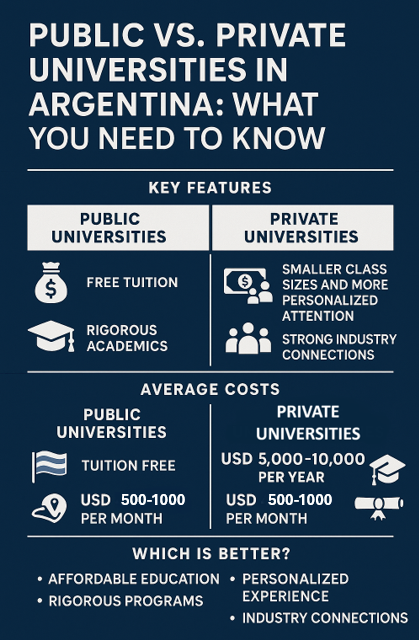Public vs. Private Universities in Argentina
Discover the key differences between public and private universities in Argentina. Learn about tuition costs, academic quality, class sizes, and which option best fits your educational goals and budget.
STUDIESEDUCATION
5/27/20253 min read


When choosing where to study in Argentina, one of the first decisions you’ll face is whether to attend a public or private university. Each option has its own advantages and considerations, and the decision will depend on various factors such as your budget, academic goals, and preferred location. In this article, we’ll take a closer look at the differences between public and private universities in Argentina, the average costs associated with each, and which type of school might be the best fit for your academic journey.
Public Universities in Argentina: Key Features
1. Free Tuition
Public universities in Argentina are tuition-free for both local and international students. This makes them an extremely attractive option for those looking to minimize the financial burden of higher education. The country’s commitment to accessible education means that public universities provide high-quality programs without charging tuition fees.
2. Rigorous Academics
Public institutions, like Universidad de Buenos Aires (UBA) and Universidad Nacional de La Plata (UNLP), are renowned for their academic rigor. These universities typically have a wide range of programs and a strong emphasis on research and academic freedom. However, entrance requirements can be competitive, and some programs might require specific entrance exams.
3. Location and Size
Public universities are often larger in size and located in major cities, like Buenos Aires, Córdoba, and La Plata. This offers students access to a vibrant academic community, extensive resources, and numerous extracurricular opportunities. However, the sheer size of these institutions can sometimes lead to crowded classrooms and a less personalized experience.
Private Universities in Argentina: Key Features
1. Tuition Fees
Private universities in Argentina typically charge tuition fees. The costs can vary depending on the institution and program, but they are generally more expensive than public universities. For example, at Universidad Torcuato Di Tella (UTDT), tuition fees for business or law programs can range from USD 5,000 to USD 10,000 per year.
2. Smaller Class Sizes and More Personalized Attention
Private universities tend to have smaller student populations, which allows for more personalized attention from professors and smaller class sizes. This can be an advantage for students who prefer a more intimate learning environment and direct interaction with faculty.
3. Strong Industry Connections
Many private universities, such as UTDT and Universidad Austral, have strong ties to industry leaders and businesses, particularly in fields like business, law, and economics. This can be an advantage for students seeking internships and job opportunities during and after their studies.
Conclusion
Argentina’s education system offers both public and private universities that cater to a wide variety of academic interests and budgets. Whether you choose a public or private institution, you’ll find that Argentina offers a rich academic environment, an affordable cost of living, and excellent opportunities for international students. The decision between public and private universities should depend on your academic needs, financial capacity, and personal preferences.
Comparing Costs: Public vs. Private Universities
Public Universities: As mentioned earlier, tuition is free. However, students should expect to pay for other expenses such as books, materials, and possibly registration fees. The cost of living in Argentina (accommodation, transportation, food) will also vary depending on the city you choose to study in. On average, international students can expect to spend between USD 500-1000 per month on living expenses.
Private Universities: Tuition fees at private universities can be anywhere between USD 5,000 to USD 10,000 per year for undergraduate programs. However, many private universities offer financial aid, scholarships, and payment plans to help offset the costs. Living expenses are similar to those in public universities, ranging from USD 500-1000 per month.
Which is Better: Public or Private?
The choice between public and private universities largely depends on your personal priorities and financial situation.
If you’re looking for affordable education, rigorous academic programs, and access to a wide range of fields, public universities are a solid choice.
If you prefer a more personalized educational experience, smaller class sizes, and connections to industries, a private university may be the better fit.


Need Help Choosing the Right University in Argentina?
If you have questions or need personalized guidance to find the best school for your goals and budget, feel free to contact us, we’re here to help.
Explore more posts in our Education & Student Life category
Know Argentina
Discover diverse insights about Argentina's rich culture.
Connect
stay in the loop
info@knowargentina.com
© 2025. All rights reserved.
